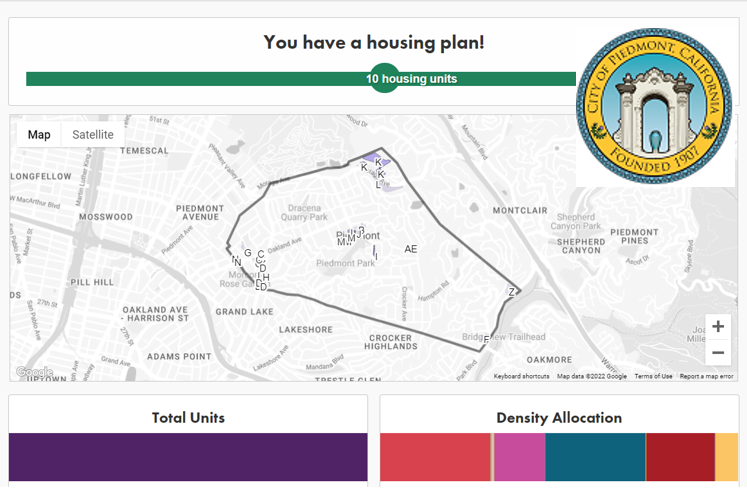Should Piedmont adhere to the the City Charter with voter control over zoning uses/classifications or forfeit control to the City Council?
What should come first – voter approval of zoning reclassifications/use changes or City Council approval of the Housing Element (HE) requiring the reclassifications/use changes?
The question is not whether or not proposed changes are good or bad; the question is who has the right to change the zoning usage/classifications? State laws have limited control over city zoning laws.
The currently proposed Piedmont Housing Element defeats the Piedmont City Charter.
The City Council proposes to change usage on public property to multiple family zoning via the Housing Element (HE). Piedmont Parks, the Arts Center, City Hall, Veterans Building, Blair Park, Skate Board Park, and Corporation Yard – historic buildings and uses are proposed for change of use.
Once the HE has specified in writing the locations of the required 587 new housing units and is approved by the City Council along with the state, the City of Piedmont is required to adhere to the zoning changes specified in the HE. The Piedmont Housing Element and General Plan are firm government commitments to to the state, commercial developers, individuals, organizations, groups, property owners to be implemented during the 8 year HE term.
The process being utilized by the City Council makes zoning changes/reclassifications the sole authority of the City Council rejecting the language within the City Charter that requires voter control over changes/reclassification of zones.
Will Piedmont voters have an opportunity to approve the change of use/ reclassification per the City Charter, or will the City Council put zoning changes in the HE and require voter approval of the zoning changes after the HE is approved? Piedmont’s proposed HE requires zoning use/reclassification turning parks and public property into multiple housing.
It has been publicly stated and proposed that park land would be declared surplus property and sold or reused/reclassified without voter approval.
Piedmont’s five zones are classified as: public, commercial, multi-family, single-family and single-family Estate – with all zones permitting single-family housing. In Piedmont, the use determines the classification of a zone.
“Classified, Reclassified, and use” are keywords within the City Charter.
Voter approval on zoning is well established in Piedmont per the voter approved Piedmont City Charter. Only voters can change zone usage/classifications. Adherence to the City Charter is not a matter of how much it cost to adhere to the Charter; adherence is a matter of law.
The words “classification and reclassifications”, describe the “use” within a zone as can be seen by reading the City Charter copied below:.
City Charter ARTICLE IX. General Provision
SECTION 9.02 ZONING SYSTEM The City of Piedmont is primarily a residential city, and the City Council shall have power to establish a zoning system within the City as may in its judgement be most beneficial. The Council may classify and reclassify the zones established, but no existing zones shall be reduced or enlarged with respect to size or area, and no zones shall be reclassified without submitting the question to a vote at a general or special election. No zone shall be reduced or enlarged and no zones reclassified unless a majority of the voters voting upon the same shall vote in favor thereof; provided that any property which is zoned for uses other than or in addition to a single-family dwelling may be voluntarily rezoned by the owners thereof filing a written document executed by all of the owners thereof under penalty of perjury stating that the only use on such property shall be a single-family dwelling, and such rezoning shall not require a vote of the electors as set forth above..
Since all zones allow single-family development, Michelle Kenyon, Piedmont’s contract City Attorney, stated in regard to the HE’s proposed changes that multiple family housing is housing, and therefore allowed in all zones. Kenyon has used other cities’ definitions of “classification and reclassification”, rather than relying on language found in Piedmont’s City Charter with “use” determining a classification.
City Attorney Kenyon has instructed the Piedmont City Council and Planning Commission that Piedmont voter approval of the proposed land use changes/reclassifications are not required because: no new zone is being created; no zone is being enlarged; no zone is being reduced. Importantly, Kenyon’s advice results in the ability of the City Council to change the use/ reclassification of zones without voter approval.
City Charter ARTICLE IX. General Provision:
SECTION 9.02 ZONING SYSTEM (Excerpt from above)
“provided that any property which is zoned for uses other than or in addition to a single-family dwelling may be voluntarily rezoned by the owners thereof filing a written document executed by all of the owners thereof under penalty of perjury stating that the only use on such property shall be a single-family dwelling, and such rezoning shall not require a vote of the electors as set forth above.”
As noted above, the City Charter allows property owners in the multifamily or commercial zone to rezone their property to exclusively be for single-family zoning. The City Charter in this section informs the definition of “classification and rezoning” as “use” in the zones. It is unknown how the Kenyon opinion accommodates the zone use/ classification language written into the City Charter.
Timing:
The City Council has known for over a year, there would be significant challenges to Piedmont zoning to accommodate 587 new housing units in Piedmont; while other cities have allowed voter participation, Piedmont voters have not been given a chance to act on the zoning per the City Charter, The deadline for placing a ballot measure on the November 2022 ballot ends in August.
What if voters do not approve the HE changes? Are voters no longer permitted to approve or disapprove the zoning changes? Does the City Council plan to follow outside counsel advice and eliminate voter approval?









